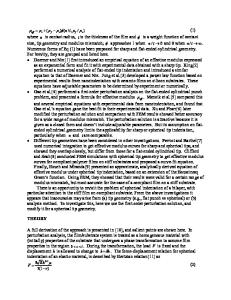Extracting the elastic and viscoelastic properties of a polymeric film using a sharp indentation relaxation test
- PDF / 323,565 Bytes
- 10 Pages / 585 x 783 pts Page_size
- 89 Downloads / 381 Views
K.Y. Zeng Department of Mechanical Engineering, National University of Singapore, Singapore 119260
L. Shen Institute of Materials Research and Engineering, Singapore 117602
Y.Y. Wang Institute of High Performance Computing, Singapore 117528 (Received 12 January 2006; accepted 10 May 2006)
A new approach is proposed to extract the elastic and viscoelastic properties of a polymeric film on a hard substrate using a sharp indentation relaxation test. In the theoretic formulation, a sharp indentation relaxation test on a film/substrate system was interpreted by its equivalent flat-ended punch indentation relaxation test. The radius of the equivalent flat-ended punch was determined by the residual depth of the sharp indentation. A semi-analytical solution for a flat-ended punch relaxation test was derived. Sharp indentation relaxation tests on a polymethyl methacrylate film and a polycarbonate film on a glass substrate were performed. The semi-analytical solution and the experimental results were used to extract the elastic-viscoelastic parameters of the films. The extracted elastic-viscoelastic parameters of both films were found to be in a good agreement with data sheets of the films. The proposed approach provides a simple and yet feasible way to extract “film-only” elastic and viscoelastic properties.
I. INTRODUCTION
Indentation techniques have been widely used to extract the mechanical properties of elastic-plastic materials. However, indentation techniques face two challenges when applied to extracting the mechanical properties of a polymeric thin film in a thin film/substrate system. First, it is difficult to extract “film-only” mechanical parameters by indentation tests because of the presence of the substrate. It was shown that the measured elastic modulus of a soft film is strongly affected by the hard substrate if Oliver and Pharr’s analysis procedure is used.1 To eliminate the influence of substrates, a commonly used rule of thumb is to limit the indentation depth to less than 10% of the film thickness.2 However, it was found that the substrate influence cannot be neglected even at a very small indentation depth if the elastic mismatch between the film and the substrate is large,1 making this rule questionable when studying the elastic-viscoelastic properties of a polymeric film overlying a hard substrate.
a)
Address all correspondence to this author. e-mail: [email protected] DOI: 10.1557/JMR.2006.0395 J. Mater. Res., Vol. 21, No. 12, Dec 2006
Second, the time-dependent deformation, that is, the viscoelasticity and viscoplasticity, poses another challenge to using indentation techniques to extract the mechanical properties of polymeric materials. It is well known that the loading and unloading curves are time dependent and therefore cannot be determined uniquely by conventional indentation procedures. Because of the complexity of the deformations during indentation tests, many researchers have applied approaches to separate the elastic, plastic, and viscoelastic/ viscoplastic deformations and study t
Data Loading...











